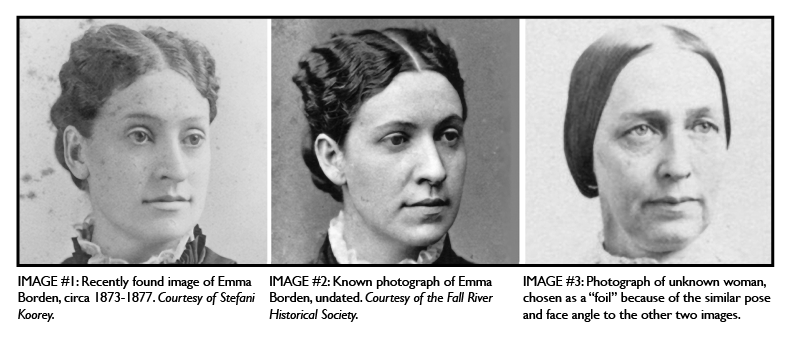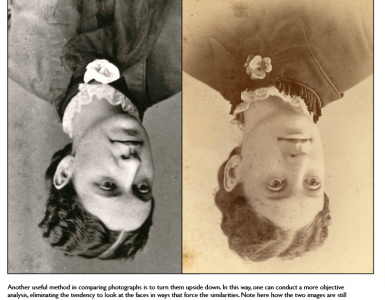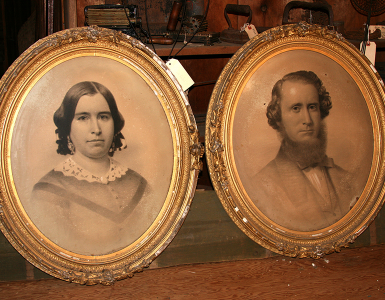by Stefani Koorey
First published in Spring, 2009, Volume 6, Issue 1, The Hatchet: Journal of Lizzie Borden Studies.
The email arrived eight days before Christmas. It was from Deb Allard, the reporter for the Fall River Herald News who has always been interested in all things Lizzie and has penned many a piece on the case—including the recent photographic discoveries.
After the pleasantries, Deb got to the meat of her message. She had received an email from a woman in Wisconsin who told her that the Emma Borden photograph I had discovered, and that Deb had written about (Fall River Herald News, 10 December 2008, “A New Development in Borden History”), was not Emma Borden, but a family member of hers named Alice Matthias. She had the same photograph in her family album, a collection that had been given to her by her great aunt.
After getting this message, Deb had done some searching at the Fall River Historical Society and discovered that there indeed had been an Alice Matthias in Fall River. She had been a nun, and was born in 1849. She served with the Sisters of Mercy, then located at 185 Second Street.
While there were no other photos of Alice in her collection, or any proof this image was she, the woman was positive that the image I had found was Alice and not Emma. Deb asked me if I would like to comment.
I was intrigued. I had conducted extensive research to date the image and the photo studio where it was taken. I had carried out multiple photographic comparisons of this image with the only other known photograph of Emma Borden as an adult, the original of which is held by the Fall River Historical Society. Luckily, the woman in both images was sitting in the same pose, with the same side of the face exposed. I had overlaid the new found image over the old known one, and discovered them to match almost exactly. I wrote about that process at length in the last issue of The Hatchet (November 2008). I was fairly confident I had the real McCoy, and set to thinking about the possible explanations as to why this woman would have an Emma Borden photograph in her family album, and how I could further prove my case.
I know from my research that there are scientists who are currently working on algorithms that compare photographs to determine whether the images are the same person. Facial recognition is part of the emerging technologies in security systems. Airports, governments, and secret agencies are all exploring ways in which we can determine if we are who we say we are, if a person in a crowd can be identified, even with a concerted effort to change appearance (with the altering of facial hair, clothing, makeup, or prosthetics). Major universities around the world are engaged in research into mathematical formulas that can be used to solve these very real problems.
I thought that if I could contact a few of these experts, share my images, and ask their opinions, I would have further evidence that my initial work and pronouncement had been correct. Of course, there was also the chance that the experts would tell me that I was mistaken and that these were two entirely different people. But I was prepared to accept the truth of their work, no matter the outcome. Once you open up to professional opinions, you have to take the consequences—even if they might prove embarrassing.
I asked Deb to wait a few days so I could find some experts to run some tests. I told her that while I still believed that I was correct, I was certainly open to admitting any error on my part in the identification. I asked her to further pursue asking the woman in Wisconsin if she had any other images of this Alice from her album, or any other images identified as such. I felt that there were some perfectly good explanations as to why this lady might have an Emma in her collection. Heck, even the Borden family photo album had a Tom Thumb (Charles Stratton) family card in it!
Deb spoke with her editor and he agreed to hold off while I contacted some experts. In the meantime, she was also going try to get some additional information from the woman to help us with that end of the tale.
By December 20th, three days later, I had news for Deb about the “Emma” photograph.
Through my work with Thomas Mauriello, Lecturer/Consultant in Criminalistics at the University of Maryland, Department of Criminology and Criminal Justice (interviewed in The Hatchet, February 2008), I was given the contact information for a professional facial reconstruction artist who was a colleague of Tomm’s at the crime lab.
Eve Kingsley Booth agreed to help me and promised to examine the images and offer her opinion. Booth is certified in both police composite artistry and two and three dimensional reconstruction from the skull.
After I sent her the two images, she wrote that she had seen a “superficial likeness on first blush,” but wanted to take a long close look at them before saying anything further, particularly because the age difference between the two photographs could be anywhere from seven to seventeen years. She said that “age progression makes a big difference, particularly in a woman in her 20s to 30s.”
Her report, which was given to me within a day, said the following:
Based on a number of landmarks I compared, I think we are most likely looking at the same woman. They are strikingly similar in many ways. Below are my notes:
Ears: The ear is as specific to each person as their fingerprint, and although it does become fleshier and can appear to become set lower on the head with time, the basic structure does not change. I took a very long look at the two, and although at first blush they look different, a close look has them pretty similar.
Eyes: The lids on the unknown photograph are very thick and heavy. That type of lid will naturally become very heavy and droop, usually in one corner, over time. The known photograph’s lids are not drooping as I would have expected. Not conclusive, but it would have helped me to feel absolutely positive these were the same women. Her brows are lower in the known photo, but that is common with advancing age.
Lips: The known photo has a more prominent ‘cupid’s bow’ area to the upper lip. This area lengthens over time but does not become more or less structured, but this could be attributed to the position of Emma’s mouth when she was photographed. The first photograph has the mouth in a more relaxed position. The lips themselves are very similar in structure, and are placed similarly on the face. They are slightly lower on the face, but again, that is common with age.
Nose: The tip of the nose is slightly down-turned in the later picture, a common artifact of age. The basic shape and structure of the nose is similar.
This was a very, very close call. It came down to looking at very small details, but things that wouldn’t change, no matter what the age, or whatever life happened to have thrown at this lady. The main things that had me looking very closely were the fact that she is very heavy-lidded in the unknown photo, and appears less so in the known photo, the arch of her brows was not an exact match, and although we can attempt to artificially change the hair on our brows, the bone structure beneath stays the same. The alar area of her nose, which is the nasal wing appears more squat and flaring on the unknown photo, but again, our noses are easily altered by our facial expression, particularly the alar portion, so it is hard for me to place any real stock in that.
I’d say, the differences I see are superficial and explained by the passage of time or facial expression, the similarities I see are structural. That tells me that you’ve either got a photo of the same woman several years later, or a picture of a very close relative who is several years older.
At the same time that I had contacted Thomas Mauriello for a referral, I had also written to six of the world’s leading research scientists working in facial recognition and algorithmic formulas to determine identity. Several were in the United States, but some were abroad. I was very pleased to get some responses to my query,.
One such response was from Dr. Mislav Grgic, from the University of Zagreb in Croatia. He felt that my best bet would be to contact Dr. Irving Biederman at the University of Southern California. Using Dr. Grgic’s name when I contacted Dr. Biederman opened the door to this renowned scientist, and he agreed to assist me in my quest. All of this communication, by the way, occurred during and around Christmas and New Years, when the universities where they worked were closed for semester breaks and the holidays, Each of these experts took time from their families to assist me. For this extraordinary kindness, I am truly grateful.
In response to my request, Dr. Biederman wrote the following to me:
The face recognition model (the Gabor-jet system) that we use does a good job of mimicking human judgments of the similarity of face images, but it is not designed to provide ‘ground truth’ as to whether two highly similar face photos are actually of the same person. I believe that there is software around that would measure the ratio of hand-positioned bony landmarks on the face that might be more appropriate for that. Even with such a model, they could not provide absolute truth, merely some range of physical similarity. What they could do—and what we could do with our own model—is provide some assessment as to whether picture A is more similar to picture B than to picture C. For us to do it with the current software, not only would the faces have to be at the same pose (orientation to the camera) but also with the same direction of lighting. These controls are necessary because we are measuring the similarity of the images, not the underlying 3D structure of the face.
Dr. Biederman copied his email to Dr. Xiaomin Yue, a former student of his who is now at Mass. General Hospital at Harvard. He would run the Gabor-jet system, which was developed by a former colleague, Professor Christopher von der Malsburg, who is now at the Frankfurt Institute for Advanced Studies. He requested that I send the two images plus a third image, to be used as a foil. Of course, this I did.
Dr. Xiomin Yue, from the Martinos Center for Biomedical Imaging, Mass. General Hospital, Harvard University, offered this analysis:
I used our model to compare similarity of three images (see attached). The first image is more similar to the third image than the second image. The similarities according to our model are: sim(first, third) = 0.6726, sim(second, third) = 0.6091. The similarity of the first and the second is 0.7588. If two images are identical, the similarity should be equal to one. Due to many reasons such as the factors Dr. Biederman mentioned in his email, the similarity of two images of a same person might not be equal to one.
To this, Dr. Biederman concluded:
Dear Dr. Koorey:
My guess is that the higher similarity of the first to the third image may be more a function of the greater similarity in lightness in the images and the background. It is clear that the 1st and 2nd images are about as close a match as one can get. They even have, what appears to identical clothing, and—perhaps more impressive—is the rise of the curl on the right side of her part is higher than on the left. Unless they went to the same hairdresser, this is a striking resemblance. About the only difference that I could detect between the faces shown in 1 and 2 is in the right ear, where the outer right seems to be more pronounced in 1 than in 2. But this could be an effect of the pose and lighting angle than a real difference in configuration. I would judge 1 and 2 to be the same person—or about as close as one can find the appearances of two different people.
So there it was—expert analysis concluding that the image that I had discovered was indeed Emma Borden—unless, of course, the known image of Emma held by the Fall River Historical Society is not Emma but Alice Matthias!
So now my mind turned to the possible reasons why this woman in Wisconsin had an image of Emma Borden in her album. After speaking with Deb Allard from the Herald News on the phone, I learned that she was unable to get any further information from her contact, and that her requests for photographs of the album or family genealogy or details of their connection to this Alice Matthias had gone unanswered.
Regardless, it is possible to assume a few things based on the few morsels of facts that were shared with me and Deb from the lady from Wisconsin. Since there really was an Alice Matthais in Fall River, it is possible that she was an intimate of Emma Borden’s and was merely including her friend’s photo in her album. Deb told me that the reverse of the image the woman wrote her about was inscribed to Aunt someone from Alice. This does not prove that the image is of Alice, as the lady assumed—it could be merely be a photograph that had been inserted in a letter from Alice.
Since the woman in Wisconsin didn’t have any other images marked with or by Alice in her album, it would be impossible for her to know for certain that this photo is really an image of Alice.
The more interesting story to me is that this Alice, who was a Sister of Mercy, and a Catholic, was a friend of Emma’s to the degree that she gave her photo to her. Born in 1849, Alice would have been but three years older than Emma. The Sisters of Mercy were located at 185 Second Street. At the time the image was taken, this would place the Borden home on the same street, approximately five to six blocks away. These young women could have associated because of their proximity, encountering one another on the street, or having mutual friends.
Until we are able to learn more about the family that also owns this newly discovered Emma image, we might not be able to take this story much further. With luck, the woman from Wisconsin will once again surface to Deb Allard, and we can begin to learn more about what might prove to be a very interesting friendship between a young Catholic nun and the daughter of a Fall River businessman.








